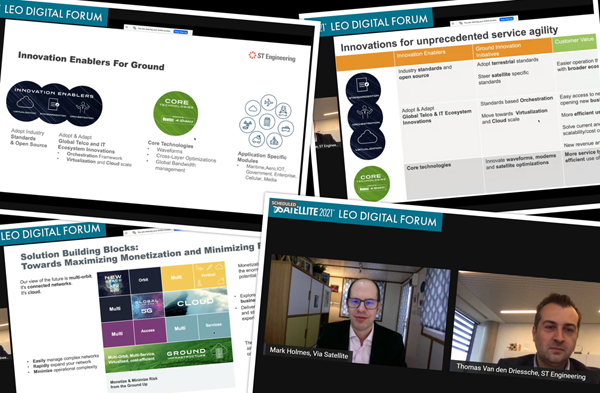 By Thomas Van den Driessche, President & CCO, ST Engineering iDirect
By Thomas Van den Driessche, President & CCO, ST Engineering iDirect
The satellite sector is undergoing the biggest transformation in its history and at the root of it all is New Space innovation. We’re moving into new orbits, moving towards new, configurable satellite designs and new business models. And as we saw last week during the Satellite Show’s LEO Forum, interest in this new era is surging as operators, launch providers, service providers and equipment manufacturers learn more about what is expected of them and how they will need to collaborate. This move to NGSO (Non-Geostationary Satellite Orbit) is now pushing the entire ecosystem towards new ways of thinking.
I wanted to re-cap on the keynote that I gave during the Forum last week on LEO: Maximizing Monetization, Minimizing Risk from the Ground Up. Here are the five key takeaways that I’d like to highlight.
Takeaway 1 – Innovation in space is being matched by telco advancements
New Space innovation is driving the satellite industry forward. From GEO, MEO and LEO to Very High Altitude satellites, there’s a lot of the power and scalability being introduced. There’s also been a considerable uplift in throughput with terabit-capable constellations, beams that switch from static to dynamic and payloads that were previously bespoke moving towards standardization or even becoming completely software defined.
At the same time, the global telco industry is going through its own major transformation to a master 5G platform. This is not just a radio access network. There are a lot of elements that define 5G as an access technology but importantly, automation, virtualization and orchestration play central roles.
It’s in this direction that the satellite industry is now heading. As ground infrastructure technologists, we must play a unifying role. From enabling software defined satellites and networks, integration with the ecosystem, virtual infrastructure and from manual configuration to orchestrated service delivery – this is our new playground – and our role is to leverage these innovations to enable new possibilities for our customers.
Takeaway 2 – Multi-orbit and multiservice ground systems are risk-mitigating elements for service providers and end-customers
We’re moving into new orbits, moving towards new, configurable satellite designs and new business models.
To unlock the potential of multi-orbit, the ground system is integral. There are many requirements for multi-orbit constellations, but a primary consideration is the ability to dynamically utilize space resources and to orchestrate and enable these resources from a service perspective. The ground segment must be capable of dealing with flexible or focused capacity, electronically formed and scalable beams, inter-satellite links and the trade-offs between routing through satellites and ground segment stations. To be able to cater for such a spectrum of requirements, the ground segment must leverage virtualization and orchestration so that it can offer the scalability and flexibility needed.
For example, orchestration deals with the resource management and definition of services, but it also becomes an enabler when setting up networks and deploying new services. The move towards an orbit-agnostic, multi-orbit ground segment will create a market boost. We will be able to provide satellite service providers with the capability to offer a range of services and to ease the decision of which type of satellite, payload or coverage and business model to use.
However, to do that we need NGSO capable modems that can handle the range of bandwidth requirements from very low to very high. And we need a range of versatile satellite terminals that can work seamlessly on NGSO including trackable antennas, parabolic and phased array designs, and we need flexible baseband solutions. To monetize multi-orbit constellations means a lot more than just enabling it.
In addition to NGSO modems and antennas, application specific elements must be implemented that cover multiple applications such as base-station connections for cellular backhaul, maritime connectivity from fishing boats to cruise ships, inflight connectivity as well as the elements of differentiation that are required by the government market to the media market. This effort and awareness opens up the multi-orbit window to those markets that are waiting to be monetized further.
Takeaway 3 – The Cloud will allow us to explore new business models that we haven’t thought of before
The Cloud is an essential enabler of the ground segment. According to Gartner Research, by 2025, 50% of enterprise workloads will leverage hyperscale cloud on premises, at the edge or in the public cloud. It will allow the expansion, optimization, creation and monetization of services.
At the same time, the cloud also opens up huge possibilities to deliver on a multi-orbit approach, to carry out resource orchestration and to implement APIs, and resource controls.
Takeaway 4 – Satellite will need to seamlessly integrate into the broader telco market
We have the ability to offer greater simplicity, reducing operational complexity thus enabling us to offer the services that our customers want and need, in a seamless way.
Satellite is now being viewed as an integrated access technology for 5G. We are adopting proven, standards-based technologies from the telco and IT world such as 3GPP and MEF, to fast-track innovations in the satellite industry. But it’s not all about standards. In between the hubs and terminals on the satellite, technology is required that needs to be optimized. This is our ‘secret sauce’ as ground segment providers.
Takeaway 5 – We need to embrace innovation and answer the market call for service agility
We can use the unique capabilities of ground segment innovation to make the difference in terms of monetization. Using the core technologies of ground segment, whether its waveforms, cross layer optimization or global bandwidth management, we need to offer multiple ways to provide connectivity to the customer. This agile approach will enable our customers to serve different applications and to differentiate their service offerings. Through looking at and learning from 5G, we can operate and integrate with the broader ecosystem of the telco and enterprise environment. We can introduce new business models to enable our customers with faster and more cost-effective ways to build, provision and deploy networks. Our goal is to help them monetize services faster by entering new markets or to grow more cost-effectively with their customers’ demands.
Rising to the challenge
We relish the challenge that the new connectivity landscape puts before us. We have the ability to offer greater simplicity, reducing operational complexity thus enabling us to offer the services that our customers want and need, in a seamless way.

